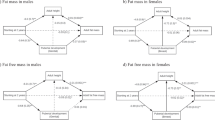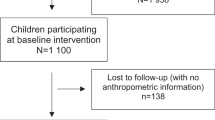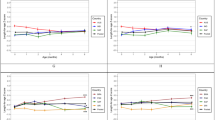Abstract
Background:
Cross-sectional studies have shown associations between stunting and overweight; however, there are few prospective studies of stunted children.
Objectives:
To determine whether stunting before age 2 years is associated with overweight and central adiposity at 17–18 years and whether growth in height among stunted children predicts body mass index (BMI) in late adolescence.
Design:
Prospective cohort study.
Participants:
One-hundred and three participants stunted by age 2 years and 64 non-stunted participants (78% of participants enrolled in childhood). Participants were measured in early childhood and at ages 7, 11 and 17 years.
Results:
Stunted subjects remained shorter and had lower BMIs, smaller skinfolds and circumferences than non-stunted subjects. Overweight (BMI ⩾25 m2) was not significantly different among stunted and non-stunted male subjects (5.2 and 12.5%) but non-stunted female subjects were more likely to be overweight than those who experienced early childhood stunting (11.1 and 34.4%, P=0.013). Centralization of fat (waist to hip ratio (WHR), subscapular/triceps skinfold ratio (SSF/TSF)) did not differ between stunted and non-stunted groups (mean WHR 0.77 and mean SSF/TSF 1.18 in both groups). Stunted subjects with greater increases in height-for-age for the intervals 3–7 and 7–11 years had higher BMI at age 17 years (P=0.04 and P=0.001, respectively).
Conclusion:
Participants stunted by age 2 years were less likely to be overweight than those who were never stunted. This suggests that cross-sectional studies of the association between stunting and overweight may be misleading. Among stunted children, greater linear growth during mid- to late childhood was associated with greater BMI at age 17 years.
This is a preview of subscription content, access via your institution
Access options
Subscribe to this journal
Receive 12 print issues and online access
$259.00 per year
only $21.58 per issue
Buy this article
- Purchase on Springer Link
- Instant access to full article PDF
Prices may be subject to local taxes which are calculated during checkout

Similar content being viewed by others
References
United Nations System SCN. Fifth report on the world nutrition situation. SCN: Geneva, Switzerland, 2004.
Monteiro CA, Conde WL, Popkin BM . Is obesity replacing or adding to undernutrition? Evidence from different social classes in Brazil. Public Health Nutr 2002; 5: 105–112.
Popkin BM . The nutrition transition and obesity in the developing world. J Nutr 2001; 131: 871S–873S.
Sawaya AL, Dallal G, Solymos G, de Sousa MH, Ventura ML, Roberts SB et al. Obesity and malnutrition in a Shantytown population in the city of Sao Paulo, Brazil. Obes Res 1995; 3 (Suppl 2): 107s–115s.
Jackson M, Samms-Vaughan M, Ashley D . Nutritional status of 11–12-year-old Jamaican children: coexistence of under- and overnutrition in early adolescence. Public Health Nutr 2002; 5: 281–288.
Popkin BM, Richards MK, Montiero CA . Stunting is associated with overweight in children of four nations that are undergoing the nutrition transition. J Nutr 1996; 126: 3009–3016.
Mukuddem-Petersen J, Kruger HS . Association between stunting and overweight among 10–15-y-old children in the North West Province of South Africa: the THUSA BANA Study. Int J Obes Relat Metab Disord 2004; 28: 842–851.
Hoffman DJ, Sawaya AL, Verreschi I, Tucker KL, Roberts SB . Why are nutritionally stunted children at increased risk of obesity? Studies of metabolic rate and fat oxidation in shantytown children from Sao Paulo, Brazil. Am J Clin Nutr 2000; 72: 702–707.
Sawaya AL, Grillo LP, Verreschi I, Da Silva AC, Roberts SB . Mild stunting is associated with higher susceptibility to the effects of high fat diets: studies in a shantytown population in Sao Paulo, Brazil. J Nutr 1998; 128: 415S–420S.
Walker SP, Gaskin PS, Powell CA, Bennett FI . The effects of birth weight and postnatal linear growth retardation on body mass index, fatness and fat distribution in mid and late childhood. Public Health Nutr 2002; 5: 391–396.
Benefice E, Garnier D, Simondon KB, Malina RM . Relationship between stunting in infancy and growth and fat distribution during adolescence in Senegalese girls. Eur J Clin Nutr 2001; 55: 50–58.
Schroeder DG, Martorell R, Flores R . Infant and child growth and fatness and fat distribution in Guatemalan adults. Am J Epidemiol 1999; 149: 177–185.
Li H, Stein AD, Barnhart HX, Ramakrishnan U, Martorell R . Associations between prenatal and postnatal growth and adult body size and composition. Am J Clin Nutr 2003; 77: 1498–1505.
Ong KK, Ahmed ML, Emmett PM, Preece MA, Dunger DB . Association between postnatal catch-up growth and obesity in childhood: prospective cohort study. BMJ 2000; 320: 967–971.
Hamil P, Drizd T, Johnson C, Reed R, Roche A . Growth curves for children, birth–18 years 165 (DHEW # 78-1650) National Center for Health Statistics: Hyatsville, MD, 1977.
Grantham-McGregor SM, Powell CA, Walker SP, Himes JH . Nutritional supplementation, psychosocial stimulation, and mental development of stunted children: the Jamaican Study. Lancet 1991; 338: 1–5.
Walker SP, Powell CA, Grantham-McGregor SM, Himes JH, Chang SM . Nutritional supplementation, psychosocial stimulation, and growth of stunted children: the Jamaican study. Am J Clin Nutr 1991; 54: 642–648.
Powell C, Grantham-McGregor S . Home visiting of varying frequency and child development. Pediatrics 1989; 84: 157–164.
Grantham-McGregor SM, Walker SP, Chang SM, Powell CA . Effects of early childhood supplementation with and without stimulation on later development in stunted Jamaican children. Am J Clin Nutr 1997; 66: 247–253.
Walker SP, Grantham-McGregor SM, Himes JH, Powell CA, Chang SM . Early childhood supplementation does not benefit the long-term growth of stunted children in Jamaica. J Nutr 1996; 126: 3017–3024.
Lohman TG, Roche A, Martorell R . Anthropometric Reference Manual. Human Kinetics Books: Champaign, IL, 1988.
Kuczmarski RJ, Ogden CL, Grummer-Strawn LM, Flegal KM, Guo SS, Wei R et al. CDC growth charts: United States. Advance data from vital and health statistics no. 314. National Center for Health Statistics: Hyattsville, MA, 2000.
Mendez MA, Cooper RS, Luke A, Wilks R, Bennett F, Forrester T . Higher income is more strongly associated with obesity than with obesity-related metabolic disorders in Jamaican adults. Int J Obes Relat Metab Disord 2004; 28: 543–550.
Freedman DS, Khan LK, Mei Z, Dietz WH, Srinivasan SR, Berenson GS . Relation of childhood height to obesity among adults: the Bogalusa Heart Study. Pediatrics 2002; 109: E23.
Acknowledgements
We thank Amika Wright for conducting the measurements. The study was supported by a grant from the Wellcome Trust (066088).
Author information
Authors and Affiliations
Corresponding author
Rights and permissions
About this article
Cite this article
Walker, S., Chang, S. & Powell, C. The association between early childhood stunting and weight status in late adolescence. Int J Obes 31, 347–352 (2007). https://doi.org/10.1038/sj.ijo.0803383
Received:
Revised:
Accepted:
Published:
Issue Date:
DOI: https://doi.org/10.1038/sj.ijo.0803383
Keywords
This article is cited by
-
Association between anthropometric criteria and body composition among children aged 6–59 months with severe acute malnutrition: a cross-sectional assessment from India
BMC Nutrition (2022)
-
Body composition of children with moderate and severe undernutrition and after treatment: a narrative review
BMC Medicine (2019)
-
Effect of correcting for gestational age at birth on population prevalence of early childhood undernutrition
Emerging Themes in Epidemiology (2018)
-
Early growth faltering in post-institutionalized youth and later anthropometric and pubertal development
Pediatric Research (2017)
-
Are stunted young Indonesian children more likely to be overweight, thin, or have high blood pressure in adolescence?
International Journal of Public Health (2017)



